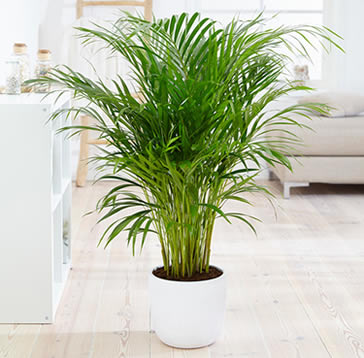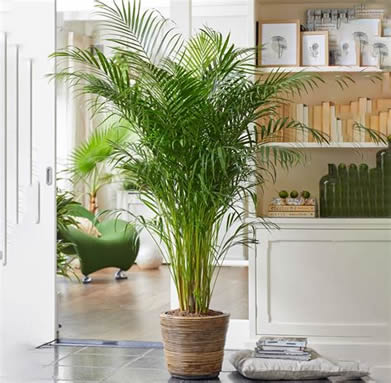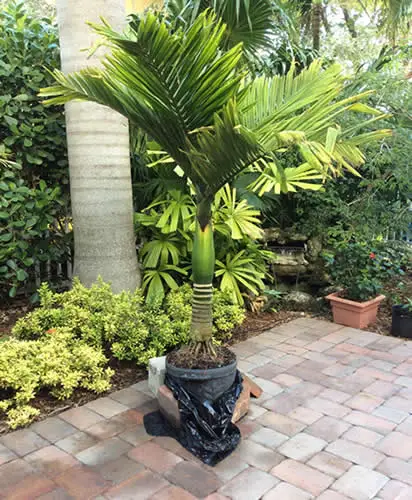The Areca Palm (Dypsis lutescens), also known as the Butterfly Palm or Bamboo Palm, is one of the most elegant and air-purifying houseplants you can grow. Its soft, feathery fronds and gentle upright growth give it a relaxed, tropical vibe that fits beautifully in bright, open spaces.
It might look like a diva, but it’s actually fairly low-maintenance when you understand its needs.
Table of Contents
- Areca Care Guide
- Bright but Gentle: Understanding the Light Preferences of Areca Palms
- Moist, Not Soggy: How to Water Your Areca Palm Properly
- Keep It Cozy: The Right Temperature and Humidity for Areca Palms
- Feeding for Fullness: When and How to Fertilize
- Time to Upgrade: When to Repot Your Areca Palm
- Tidying Up: How to Trim and Groom Your Palm
- Best Placement in the Home: Where Your Areca Palm Will Thrive
- Caring for Areca Palms Outdoors: Warm-Weather Tips for Patio and Garden Life
- Common Areca Palm Problems and How to Fix Them
- Final Thoughts
Areca Care Guide
Here’s how to grow and maintain a healthy, happy Areca Palm indoors—including everything from watering to fixing browning fronds.
Bright but Gentle: Understanding the Light Preferences of Areca Palms
Areca Palms do best in bright, indirect light. A spot near a lightly filtered south- or west-facing window is perfect.

While they can handle some gentle morning sun, strong direct light—especially in the afternoon—can burn the fronds. In lower light, they’ll grow slower and may lose their vibrant color, but they’ll still hold on.
Moist, Not Soggy: How to Water Your Areca Palm Properly
Use a lightweight, well-draining potting mix to prevent soggy roots. Water thoroughly once the top inch of soil feels dry.
Be careful not to overwater—root rot is one of the most common issues with this plant.
On the flip side, if the soil stays dry too long, the leaf tips may start browning.
Find a rhythm that keeps the soil evenly moist without letting it sit wet.
Keep It Cozy: The Right Temperature and Humidity for Areca Palms
Areca Palms thrive between 65°F and 80°F and don’t tolerate cold drafts or sudden temperature swings.

Avoid placing them near vents, air conditioners, or cold windows.
They love humidity, so mist them regularly, set them on a pebble tray, or group them near other tropical plants for added moisture in the air.
Feeding for Fullness: When and How to Fertilize
During the growing season, feed every 4 to 6 weeks with a liquid houseplant fertilizer or a formula made specifically for palms.
Always dilute to half strength to avoid salt buildup, which can cause browning.
Hold off on feeding in fall and winter when the plant slows its growth.
Use a good quality 10-10-10 fertilizer, such as this one, or a 20-20-20 fertilizer, like this one.
Time to Upgrade: When to Repot Your Areca Palm
Areca Palms like being slightly root-bound and usually only need repotting every 2–3 years.

When it’s time, choose a pot that’s just one size larger and refresh the soil completely.
Make sure your container has drainage holes to avoid soggy roots.
Tidying Up: How to Trim and Groom Your Palm
Occasional yellow or brown fronds are normal and can be trimmed off at the base with clean scissors.
Never trim just the tips—remove the entire stem if needed.
Clean dust from the fronds with a damp cloth or gentle spray to keep them breathing freely and looking their best.
Best Placement in the Home: Where Your Areca Palm Will Thrive
Areca Palms are ideal for living rooms, sunrooms, or bright home offices with indirect sunlight.
They’re especially striking in corners where their soft, arching fronds can spread out and soften the space.
Avoid tight spots where airflow is limited or cold air might hit.
Caring for Areca Palms Outdoors: Warm-Weather Tips for Patio and Garden Life
Areca Palms can be grown outdoors in warm, frost-free climates or brought outside during the summer months in cooler zones.

They love being outdoors when conditions are right, and the extra light and airflow can give them a noticeable boost in growth.
Place your palm in a bright, shaded area outdoors where it will get plenty of indirect light but be protected from harsh, direct sun.
A covered porch, under a tree, or beside a sun-dappled wall is ideal.
Make sure the pot has excellent drainage, and water more frequently during hot weather to keep the soil evenly moist.
Avoid placing it outdoors when temperatures drop below 50°F. If you’re in a seasonal climate, bring your Areca Palm back inside before autumn nights get chilly.
Give it a quick rinse or wipe-down before reintroducing it to your indoor environment to help prevent pests from tagging along.
Common Areca Palm Problems and How to Fix Them
Browning leaf tips
The most common issue with Areca Palms. Usually caused by dry air, inconsistent watering, salt buildup, or too much fertilizer.
Fix it by increasing humidity, switching to filtered water, and reducing how often you feed. Trim off the brown tips if desired, but never cut into the green part of the leaf.
Yellowing fronds
Older fronds naturally yellow and die back over time, but if it’s happening rapidly or to new growth, the plant may be overwatered or getting too little light.
Fix it by adjusting your watering schedule and moving the plant to a brighter location with indirect sunlight.
Slow or stunted growth
Usually caused by insufficient light, lack of nutrients, or being root-bound.
Fix it by improving lighting conditions, giving a diluted feed during the growing season, or checking if the roots need more room.
Spider mites or pests
Areca Palms can attract spider mites if the air is too dry.
Fix it by increasing humidity and gently wiping the fronds with a damp cloth.
For persistent pests, treat with neem oil or insecticidal soap.
Fronds turning pale or washed out
Too much direct sun can bleach the fronds.
Fix it by moving the plant out of direct sunlight and into a spot with filtered, indirect light.
Final Thoughts
The Areca Palm is one of those rare houseplants that brings height, softness, and a tropical feel without the drama.
Give it the right balance of light, water, and humidity, and it will reward you with graceful, arching fronds that make any space feel a little more alive.
With a bit of attention and a steady care routine, this palm is a peaceful, long-lasting addition to your home.
Let me know when you’re ready to move on to the next one! 🌴

